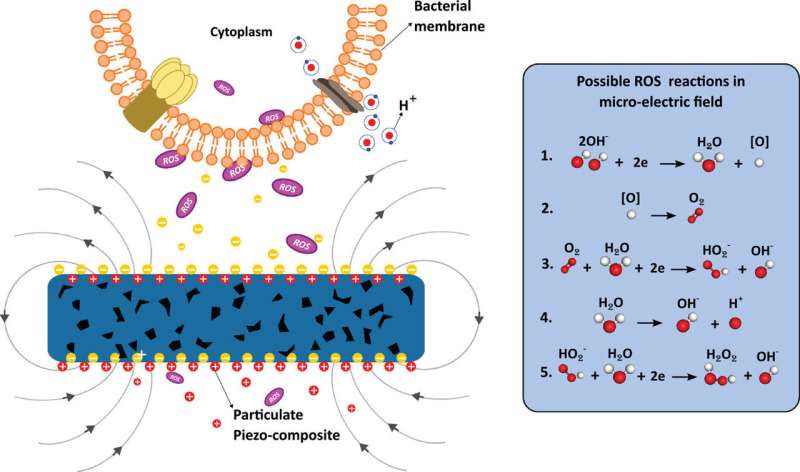This article has been reviewed according to Science X's editorial process and policies. Editors have highlighted the following attributes while ensuring the content's credibility:
fact-checked
peer-reviewed publication
trusted source
proofread
3D printed ferroelectric materials proven to eliminate harmful bacteria including E. coli

A new way of using 3D printing to create infection-fighting materials for use as medical implants has been revealed in a new research paper, published in Advanced Materials Technologies.
Engineers at the University of Bath, working with colleagues at the University of Ulster, have for the first time successfully created a new kind of ferroelectric composite material with antimicrobial properties using a novel multi-material 3D printing process.
They say the use of electrically responsive ferroelectric materials gives the implants the infection-fighting properties, making them ideal for biomedical applications, such as heart valves, stents and bone implants, reducing the risk of infection for patients.
Reducing risk
While commonplace, all biomedical implants pose some level of risk as materials can carry surface bio-contaminants that can lead to infection. Reducing this risk could be beneficial both to patients in the form of improved outcomes, and to healthcare providers thanks to reduced costs incurred by ongoing treatment.
The team has previously used this 3D printing technique for the fabrication of three-dimensional scaffolds for bone tissue engineering.
Dr. Hamideh Khanbareh, a lecturer in materials and structures in Bath's Department of Mechanical Engineering, is lead author of the research. She says that the development has the scope for wide-ranging applications.
She says, "Biomedical implants that can fight infection or dangerous bacteria such as E. coli could present significant benefits to patients and to health care providers.
"Our research indicates that the ferroelectric composite materials we have created have a great potential as antimicrobial materials and surfaces. This is a potentially game-changing development that we would be keen to develop further through collaboration with medical researchers or health care providers."
Infection-busting properties
The innovation comes thanks to ferroelectricity, a characteristic of certain polar materials that generate electrical surface charge in response to a change in mechanical energy or temperature. In ferroelectric films and implants, this electrical charge leads to the formation of free radicals known as reactive oxygen species (ROS), which selectively eradicate bacteria. This comes about through the micro-electrolysis of water molecules on a surface of polarized ferroelectric composite material.
The composite material used to harness this phenomenon is made by embedding ferroelectric barium calcium zirconate titanate (BCZT) micro-particles in polycaprolactone (PCL) a biodegradable polymer widely used in biomedical applications. The mixture of the ferroelectric particles and polymer is then fed into a 3D bioprinter to create a specific porous "scaffold" shape designed to have a high surface area to promote ROS formation.
Testing showed that even when contaminated with high concentrations of aggressive E. coli bacteria, the composite can completely eradicate the bacteria cells without external intervention, killing 70% within just 15 minutes.
More information: Zois Michail Tsikriteas et al, Additively Manufactured Ferroelectric Particulate Composites for Antimicrobial Applications, Advanced Materials Technologies (2023). DOI: 10.1002/admt.202202127
Journal information: Advanced Materials Technologies
Provided by University of Bath





















